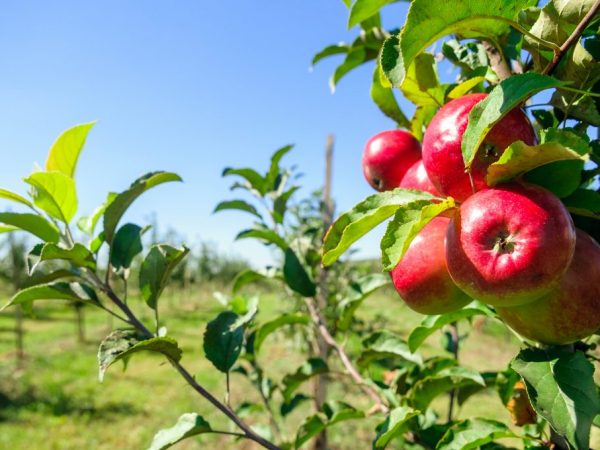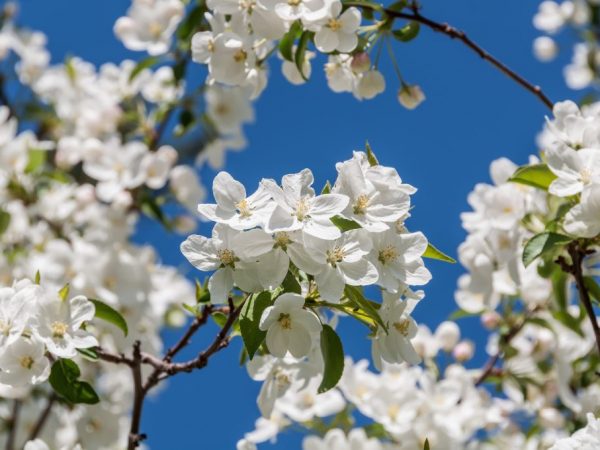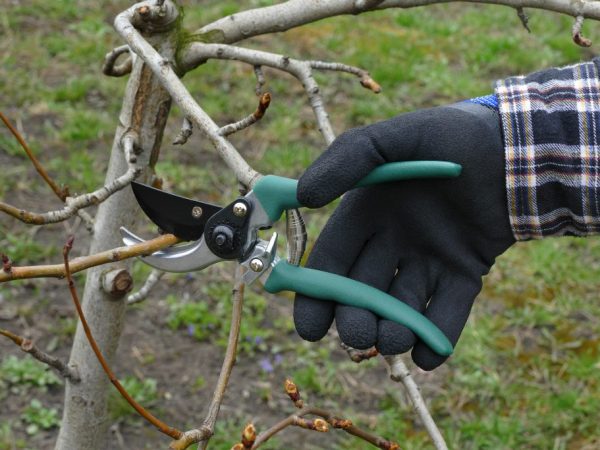Growing a Modi apple tree
The Modi apple tree is a favorite, which, despite its short period of existence, has received widespread and universal love of gardeners. It has many advantages that it borrowed from its ancestors, and its decorative appearance during flowering makes it also an adornment of the spring garden.

Growing a Modi apple tree
Variety characteristic
The Modi apple variety was bred in 1982 by crossing the Liberty and Gala apple trees. It was named after the famous artist Amedeo Modigliani.
Saplings quickly spread and became popular among gardeners in Europe and Russia.
Description of the tree and fruit
A medium-sized tree has a beautiful crown of a wide conical shape - it is easy to form. Flowering begins in May, but repeated frosts are not terrible and have no effect on the future harvest.
The fruits are beautiful, bright red with burgundy blotches, they are large, reach 200 g, have an elongated shape.
Presentation is preserved for a long time much longer, apples perfectly tolerate transportation.
Annual growth
The tree has strong skeletal branches, they grow 5-7 cm per year.
Taste
Dessert Modi apples are distinguished by high taste: they are sweet and juicy. The richness of the taste is due to the high content of acids and sugars.
The fruits are great for both self-consumption and for the production of juice, use in cooking.
The uniqueness of the taste characteristics is that they correspond to the yellow varieties of apples, while the texture of the pulp retains the juiciness and density of the green ones.
Yield
One of the few varieties that gives a good harvest even under adverse weather conditions. Fruiting is annual.
On average, 150 centners of fruits can be harvested from 1 hectare.
Pollinators
Modi apple trees are self-fruitless. Such varieties as Golden Delicious, Fuji are required for pollination. Gala is also suitable for these purposes, because they have the same flowering time.
Winter hardiness
The variety is wintry, so low temperatures do not injure the tree too much in winter.
To protect the bark in winter, it is treated with a special mixture. Clay, vitriol and lime are mixed in equal proportions and applied to the stem and the lower part of the skeletal branches.
Even after harsh winters, the buds easily awaken with the onset of warmth.
Disease and pest resistance

The variety is resistant to diseases
A feature of this variety is immunity to fungal diseases (powdery mildew or scab), as well as to pests such as aphids.
But still, preventive measures should be taken to protect against other diseases. A prerequisite is spraying trees in order to prevent the occurrence of various diseases.Insecticides are suitable for processing - Confido Maxi, Aktara, Dantop, etc.
The cleanliness of the area around the seedlings and already mature trees is also important, so it is necessary to regularly remove weeds and cut out the shoots.
Where is it grown
According to the description, the Modi apple tree can grow productively in a climatic zone that is similar to the Krasnodar Territory or the Moscow Region.
But even in regions with short summers, it grows quite successfully and yields a harvest. Areas with loamy soil and the Chernozem region are considered optimal.
Landing
Before planting, you need to decide on the site. Grown in a bright, sunny place, protected from the wind.
The apple tree does not like high groundwater levels, sandy and clayey soil. These factors adversely affect root respiration. And the sandy soil is washed out too quickly and creates a deficiency of nutrients and moisture.
The acidity should be neutral. Reduce it by introducing dolomite flour or lime.
Fertilizers containing phosphorus in their composition cannot be combined with lime, so this nuance should be thought out in advance. The time interval between the deposit of these two funds is at least 3 weeks.
Timing
Spring is considered the best time for planting an apple tree. the seedling will have time to adapt to new conditions and gain strength for wintering.
Technology
A pit for planting in the spring should be prepared in advance - in the fall. The diameter is about a meter, and the depth is 80 cm.
The soil from the upper layers is mixed with humus (1 bucket), and fertilizers are also added to the lower one (80 g of superphosphate and 40 g of potassium).
A hill is formed inside the pit from this enriched soil, and then an apple tree is placed on it so that the root collar is located higher, at a height of 5-6 cm.The roots must be carefully straightened inside the pit and pegs inserted to tie a young plant to them until it will not get stronger.
Having poured the remaining soil into the pit, it is necessary to ensure that voids with air do not form around the roots. Crown pruning is done immediately after planting - all branches are shortened by 1/3 of their length.
The compacted soil is watered abundantly, the trunk circle is mulched and then its condition is monitored - removing weeds and periodically weeding.
Care

Pruning helps the crown develop properly
In addition to the right place, timely rainfall and favorable weather conditions, the apple tree needs care.
- Pruning - done in early spring, during the dormant period (before the start of sap flow). Promotes the correct development of the crown of the tree and facilitates later harvesting;
- Watering - once every two weeks (2 buckets for a young tree and 5-6 buckets for an adult);
- Protecting the bark of the seedling from frost in winter with spruce branches and trampling snow in the peri-stem circle;
- Fertilizer - in early spring with nitrogen-containing fertilizers (500 g of urea), in the summer they use complex fertilizers (500 g of nitrophosphate and 50 g of sodium humate for each tree), and in the fall with a mixture of superphosphate and potassium taken 350 g each;
- Mulching the trunk circle;
- Strengthening adaptation and protection from frost - in the early morning or late evening, the vegetative parts of a seedling or an adult plant are sprayed with a solution of "Epin-Extra" (1 ampoule per 5 liters of water);
- The fight against diseases is more of a preventive nature, because the plant is immune to many of them - before the start of sap flow, the tree is treated with a solution of ferrous sulfate;
- Protection of the bark from cracking and pests with a clay solution.
Features of ripening and fruiting
In the presence of high-quality pollinators, fruiting is abundant, annual. At the time of the formation of the ovary, it requires thinning, because prone to fruit overload, which affects the size of future apples. Fruits do not overripe after ripening and if they are not removed from the tree on time, so harvesting can be extended for 2-3 weeks.
Harvesting and storage
Apples ripen in September. You can store the crop in a cool place until May.At the same time, nutritional, taste and commercial qualities are not lost.
Also, the fruits are practically not injured and perfectly tolerate transportation, which makes them even more valuable in the field of trade.
Gardeners reviews
The apple tree meets the high requirements of the modern market and has the following advantages:
- winter hardiness;
- excellent transportability;
- long-term storage;
- scab immunity;
- pest resistance;
- stable yield;
- high taste characteristics;
- nutritional and vitamin composition;
The decorative appearance of the crown and compact size make Modi a favorite of household plots.

